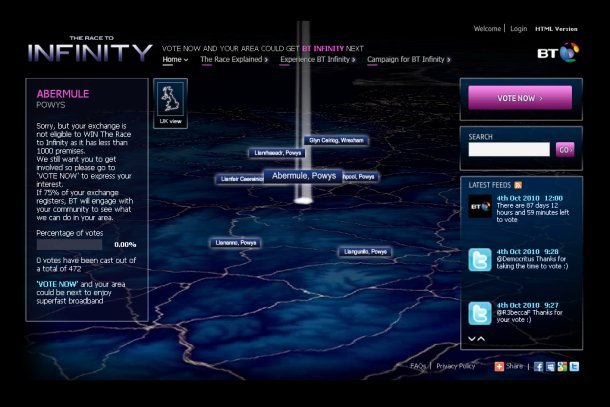BT fibre broadband: If you want it, they want to know

Your BT exchange could get upgraded to fibre if it gets enough votes...
BT has kicked off a nationwide survey to test demand for fibre broadband across the UK and help it identify areas to be included in its superfast broadband rollout.
Earlier this year BT increased the amount of money it is investing in fibre broadband infrastructure - from £1.5bn to a total of £2.5bn, pledging to cover two-thirds of the UK by 2015. And it is now asking consumers to vote for the chance to be included in that 66 per cent via its Race to Infinity website.
Superfast fibre broadband fans can bring their desire for extra bandwidth to BT's attention by inputting their postcode and nominating their local exchange. By participating in the survey BT said communities will have the opportunity to "make their voices heard" as it decides where next for fibre.
An upgraded exchange could give broadband users in the area up to 40Mpbs broadband if the upgrade is used to roll out fibre to the cabinet, or up to 100Mbps if the exchange upgrade leads to fibre in the home.

BT's Race to Infinity web survey aims to test demand for fibre broadband
(Image credit: BT)
"We want to hear from towns and villages across the UK and so I would encourage people to take part and register their interest," said Gavin Patterson, BT Retail CEO, in a statement. "The Race will map demand for fibre across the UK and so will help to influence BT's future deployment plans."
According to BT, four million premises will have access to its fibre broadband infrastructure by the end of 2010 - with more than 12 million more added by 2015 as part of its £2.5bn rollout.
BT is also running a competition to identify the top five UK exchanges with the highest demand for fibre. These five exchanges could then qualify for BT Retail funding to help get fibre by 2012. So exchanges not on BT's roadmap for fibre could be added to the list and those already earmarked for superfast broadband could get fibre faster.
Demand will be measured by the percentage of premises voting for fibre after a baseline of 1,000 votes has been reached. BT's Race to Infinity website shows the number and percentage of votes received for each exchange, and will also display the top five exchanges - once the threshold of 1,000 votes has been hit.
"All the exchanges are different so if we need to we'll go down to percentage points in terms of the percentage of premises passed [to determine a winner]," said a BT spokesman. A tie in the top five is not likely, he added. "I don't think we'll get a situation where you have a tie between two exchanges... That's just not going to happen... No two exchanges are the same."
However certain exchanges are barred from winning the competition because BT is excluding exchanges with fewer than 1,000 premises. The company says funding a rollout to such exchanges would be too expensive, even as part of this competition.
"It would just be silly to try and include those exchanges below that threshold," said the BT spokesman. "Our view is that the final third will need public sector support if it is to get fibre broadband. So we're excluding the smallest exchanges because they tend to be the most commercially challenging."
BT will still gather data on fibre demand at sub-1,000 premise exchanges through the web survey - and is not ruling out being influenced by such exchanges if there is a very high level of demand. "We are keen to gather data," the spokesman said. "Whether large [exchange] or small - because that could well help to influence our future deployment plans."
The BT fibre demand survey went live today - and will run until 31 December 2010.
In related fibre news, last week BT announced it will be investing £78.5m to bring superfast broadband - most of it fibre-based - to Cornwall and the Isles of Scilly by 2014. This £132m rural rollout is being part-financed with £53.5m from the European Regional Development Fund.